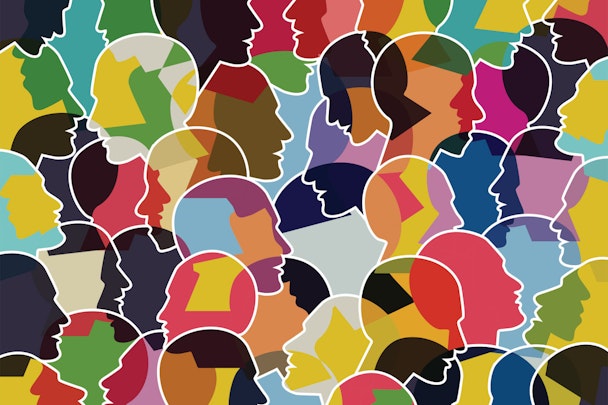Agency diversity improvements ‘marginal at best and too slow in pace’ finds IPA
UK advertising agencies are falling short when it comes to diversity, with fresh data revealing the number of employees from an ethnic minority background to have dropped over the past 12 months.

The study paints a picture of the make-up of IPA member agencies in 2019
The annual Agency Census from the Institute of Practitioners in Advertising (IPA) found that – as well as making up a smaller proportion of the UK agency workforce – staff from black, Asian and minority-ethnic (BAME) backgrounds had seen C-suite representation drop too.
The study, conducted before the Covid-19 pandemic took hold of the UK, paints a picture of the make-up of IPA member agencies in 2019. Overall, the number of employees working in the industry dropped from 25,142 in 2018 to 24,866 in 2019, which was chiefly down to the decreased use of employees on fixed-term contracts.
Of this staff base, the number of employees from a BAME background had dropped from 13.8% to 13.7%. Though diversity at junior levels was up slightly at 17.7% (up from 16.9% in 2018), just 4.7% of C-suite roles were held by employees from an ethnic minority background – marking a drop of 0.8 percentage points since 2018.
There was, however, an uptick in the number of BAME chairpeople, chief executives and managing directors, up from 2.9% to 4.1%.
The figures reveal that ad land is falling behind in meeting the IPA’s diversity targets, which are set at 15% BAME representation in leadership roles and 25% among new starters by 2020.
A widening gender pay gap
Across the UK’s agency landscape, women now account for 52.6% of total employees – up slightly from 52.2% year-on-year.
Exploring gender balance by seniority, women occupied 59.5% of junior roles, up from 58% in 2018, and 34% of C-suite roles, up from 32.7% in 2018, and up significantly from 19% in 2002.
The percentage of women in a C-suite role in 2019 was highest at 39.9% in media agencies with more than 200 employees and at 36.2% in creative and other non-media agencies with fewer than 200 employees.
Though the number of women taking a seat at the top table has increased in the past year, the IPA still noted an overall salary gap in favour of men to the tune of 24.4%, up 0.2% on 2018. Within different levels of seniority, the gender pay gap ranged from 18.7% at C-suite level to 0.9% at the junior level.
The gender pay gap was much more pronounced at creative and other agencies (28.1%) than media agencies (19.8%) across every level apart from from the C-suite. At junior level, there is a 6.4% pay gap in creative agencies – whereas at media agencies this figure is -2.2%, meaning women are being paid slightly more than men doing the same job.
The numbers give a flavour of what to expect from the industry’s official annual gender pay reports – which legally require firms with more than 250 employees to report their salary discrepancies. For now, this process has been put on hold by the UK government as businesses address the impact of the ongoing pandemic. In 2019, though, the median gender pay gap worsened at more than half of the UK's advertising and marketing agencies, closing from 18.4% in 2017-18 to 17.1% in 2018-19.
Commenting on the Census findings, IPA director general, Paul Bainsfair said: “Once again these figures show that while some improvements were noted in some areas in terms of the diversity of our industry, these are marginal at best and too slow in pace. Having said this, we do know that there is an inevitable lag between action and results.
“While there are mild fluctuations year-on-year, looking at the bigger picture over the longer term, the overall trajectory of the major trend data charted within the Census is positive."
He said the data would now help members to address diversity issues.
“In addition to tracking these numbers, we provide a wealth of diversity and inclusivity support and activity for our agencies to draw on and promote and advocate the best possible equality standards, encouraging our members to embrace those,” he added.
“To exact real change, it is incumbent upon agencies to take control. Now more than ever.”
When it came to wider industry growth, media agencies continued a 2018 trend with an increase in staff numbers, growing by nearly 400 year-on-year to 11,357. However, the number of employees at creative and non-media agencies shrunk to 13,509; a drop of over 600.
Pandemic is ‘deepening pre-existing inequalities’
With the world’s biggest ad networks, including WPP, Omnicom and Publicis Groupe, continuing to make financial and staff cuts to safeguard their businesses against the impact of Covid-19, the extent to which this will impact diversity targets remains to be seen.
However, the IPA’s associate director of diversity, Leila Siddiqi, has stressed the importance of inclusivity in these tough times: “On a societal level, the pandemic is deepening pre-existing inequalities, for example, those with lower incomes are getting poorer, mental health issues are on the rise and, according to recent United Nations policy brief about the impact of COVID19, women’s lives will be affected disproportionately and differently from men, particularly in the areas of economic impact, health, unpaid care work and gender-based violence.
“One of the most defining characteristics of a business is its culture, which is even less tangible in the current world of working remotely in a state of international emergency.
“We urge our members to preserve their core values, stay true to their culture and be mindful of changing dynamics and working inclusively in a fair and empathetic manner while we learn to navigate an online work environment.”

